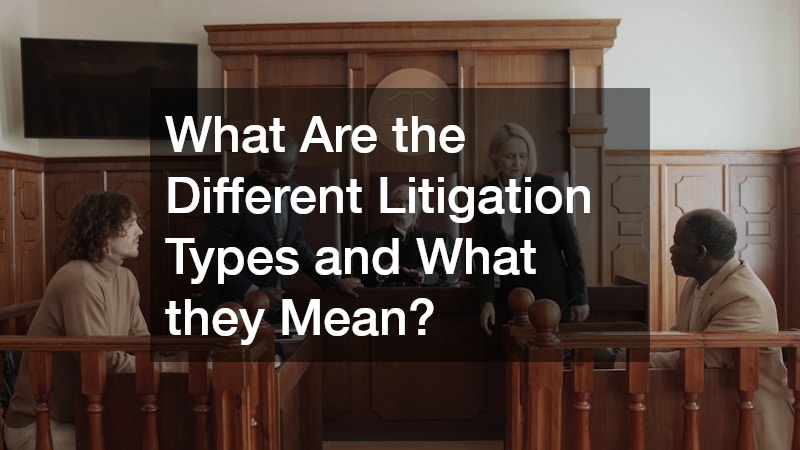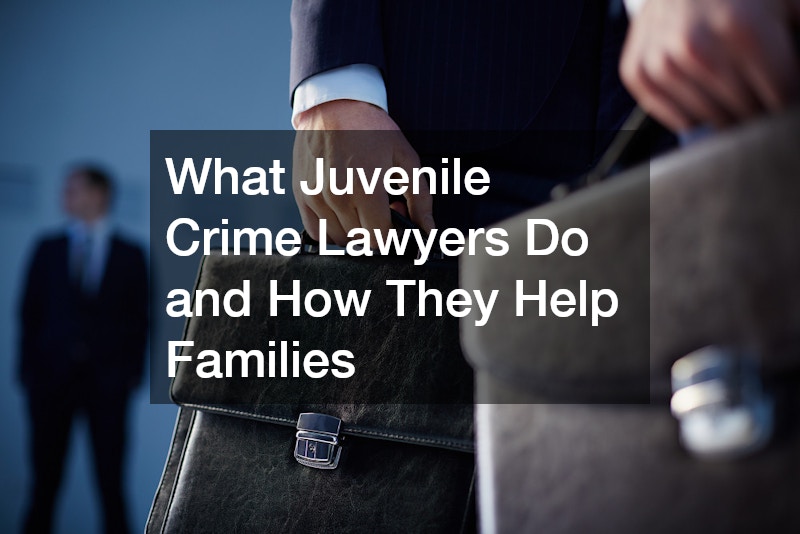The legal world is vast and complex, encompassing many processes and specialties that address a wide range of disputes. One of the most critical distinctions within the legal field is the variety of litigation types—each serving a unique purpose and following its own procedures. Whether you’re involved in a civil disagreement, a criminal case, or a commercial dispute, understanding these differences can help you make informed decisions and navigate the justice system effectively.
Litigation is, at its core, the process of resolving disputes through the court system. However, not all litigation follows the same path. Each category is governed by specific rules, standards of proof, and desired outcomes. For example, a personal injury lawsuit differs significantly from an intellectual property case or a family court proceeding.
This article explores the major litigation types commonly encountered in law today. By examining their definitions, processes, and practical implications, readers will gain insight into how each operates within the broader legal framework. Whether you’re a business owner, an employee, or an individual seeking justice, recognizing the nuances of each type will empower you to better understand your rights and obligations when legal issues arise.
1. What Is Civil Litigation?
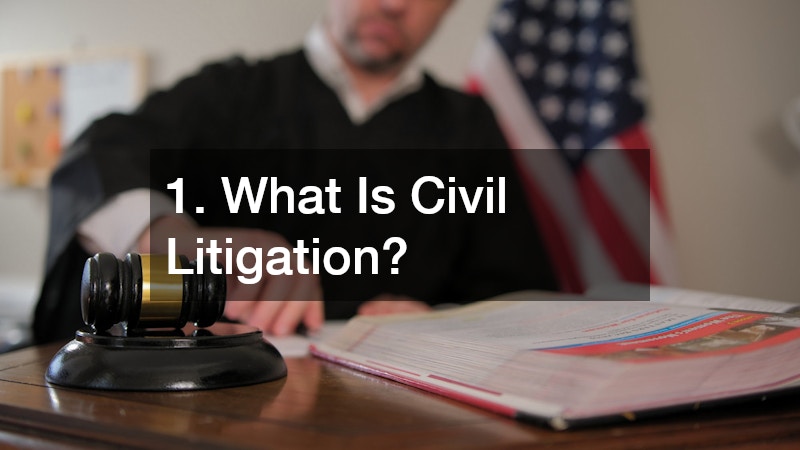
Civil litigation is among the most common and widely recognized litigation types. It encompasses disputes between individuals or organizations that involve compensation or specific performance rather than criminal penalties. In simple terms, civil litigation deals with conflicts where one party believes they’ve been wronged and seeks a legal remedy through the courts.
Cases under this category include contract disputes, property disagreements, and tort claims such as negligence or defamation. Civil litigation follows a structured process: filing a complaint, discovery (information exchange), negotiations, trial, and sometimes appeal. Each step requires careful documentation and adherence to procedural rules.
Working with local estate planning attorneys can sometimes lead to civil litigation, particularly when wills or trusts are contested. Disputes over inheritance, property distribution, or fiduciary responsibilities often end up in civil court if mediation fails.
One defining feature of civil litigation is the “preponderance of evidence” standard, meaning the plaintiff must prove that it’s more likely than not that the defendant is responsible. This lower burden of proof, compared to criminal cases, makes civil court the primary arena for private disputes.
Civil litigation promotes accountability and fairness in everyday relationships, helping individuals and businesses resolve conflicts without resorting to unlawful actions.
2. How Does Criminal Litigation Differ from Civil Litigation?
Criminal litigation is another of the key litigation types, but it differs sharply from civil cases in purpose and outcome. Whereas civil litigation resolves disputes between private parties, criminal litigation involves offenses against the state or society as a whole.
In criminal cases, the government—represented by prosecutors—brings charges against individuals or entities accused of committing crimes. These can range from misdemeanors like petty theft to serious felonies such as assault, fraud, or homicide. The primary objective is not monetary compensation but justice and deterrence, often through penalties like imprisonment, fines, or probation.
A personal injury law firm may occasionally assist victims in related civil suits following criminal trials, such as pursuing damages after a DUI or assault case. This demonstrates how different litigation types can intersect, allowing victims to seek restitution in addition to criminal justice.
Criminal litigation also uses a higher burden of proof—“beyond a reasonable doubt.” Defendants enjoy constitutional protections, including the right to counsel, the right to remain silent, and protection against double jeopardy.
Understanding this distinction is crucial. While civil cases often aim to make the injured party whole, criminal litigation seeks to uphold public order and protect the community by penalizing wrongdoing.
3. What Is Family Litigation?
Family litigation focuses on legal matters involving familial relationships, one of the more emotionally charged litigation types. These cases address issues such as divorce, child custody, alimony, adoption, and domestic violence. Because family matters often intertwine personal emotions and legal complexities, courts emphasize mediation and fair resolution.
A hit and run law firm, for example, may not directly handle family cases but often encounters family-related implications when accidents affect dependents or guardianship responsibilities. Family litigation thus connects to broader legal concerns, especially when personal injury or property issues arise during separation or divorce.
Family court proceedings tend to be less adversarial than other litigation arenas, prioritizing the well-being of children and family stability. Judges often encourage alternative dispute resolution before proceeding to trial. When court intervention becomes necessary, however, evidence regarding finances, living conditions, and parental capabilities plays a critical role.
This category underscores that litigation types aren’t only about financial or criminal consequences—they can also shape personal relationships and long-term family dynamics.
4. How Is Commercial Litigation Handled?
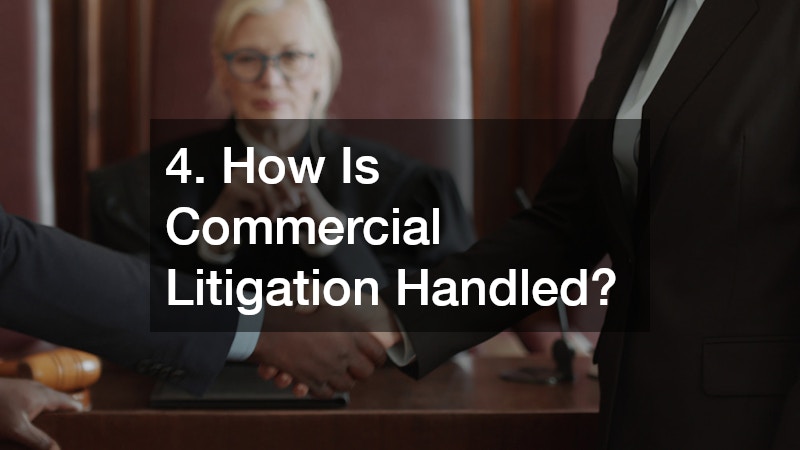
Commercial litigation covers disputes arising from business activities. It is one of the most complex litigation types, encompassing a wide range of issues such as breach of contract, partnership disputes, fraud, antitrust violations, and intellectual property conflicts.
This area demands both legal expertise and business acumen. Companies often rely on personal injury attorneys or general business litigators to represent their interests in court. The process typically begins with identifying the contractual or statutory basis for the dispute, followed by negotiations, discovery, and—if necessary—trial.
Commercial litigation can be lengthy and costly, which is why many businesses prefer arbitration or mediation before pursuing formal court proceedings. However, when significant financial stakes or reputational concerns are involved, litigation remains the most effective way to achieve resolution.
Because these cases can affect corporate operations, branding, and profitability, strategic management and documentation are essential. The outcomes often set precedents that influence future transactions and business practices.
5. What Comprises Intellectual Property Litigation?
Among modern litigation types, intellectual property (IP) litigation stands out for its focus on innovation, creativity, and competition. IP litigation involves protecting intangible assets—such as inventions, trademarks, copyrights, and trade secrets—from infringement or misuse.
In the digital era, these cases have grown exponentially, affecting individuals, artists, corporations, and technology firms alike. Disputes can arise from unauthorized reproductions, patent violations, or stolen designs. The role of specialized lawyers, often from firms dealing with injury law and other civil matters, is to help clients enforce ownership rights or defend against infringement claims.
These lawsuits require a deep understanding of both the law and technical details of the protected property. Courts may order injunctions to stop the use of protected works, monetary damages, or licensing agreements to resolve conflicts.
Protecting intellectual property ensures that creativity and innovation are rewarded. It also fosters fair competition in the marketplace, reinforcing why this category has become one of the most significant and evolving litigation areas today.
6. What Are Class Action Lawsuits?
Class action lawsuits are unique among litigation types because they allow multiple plaintiffs with similar claims to combine their cases into a single legal action. This approach promotes efficiency and fairness, especially when individual lawsuits would be impractical due to small damages or widespread harm.
Common examples include consumer fraud, defective product claims, data breaches, or environmental hazards. Class actions help ensure that corporations or large entities are held accountable for widespread misconduct.
An auto accident injury claim, for instance, may become part of a class action if a defective vehicle component caused harm to multiple individuals. These cases often attract media attention and result in substantial settlements or policy changes.
The process begins with class certification, where the court determines whether the case meets specific criteria—such as commonality and numerosity. Once approved, the case proceeds as a unified lawsuit, and any resolution applies to all class members.
By consolidating resources and claims, class actions enhance access to justice and amplify the collective voice of affected individuals.
7. How Is Employment Litigation Conducted?

Employment litigation deals with conflicts arising in the workplace, making it one of the most personally impactful litigation types. These cases cover issues like wrongful termination, discrimination, harassment, wage disputes, and contract violations.
Employees and employers alike benefit from understanding the legal framework governing these disputes. When workplace conflicts escalate beyond mediation or internal HR solutions, legal representation becomes crucial.
Many employees first pursue administrative remedies through government agencies such as the EEOC before filing a lawsuit. Employers often work with HR specialists or legal counsel to ensure compliance with labor laws and reduce the risk of costly litigation.
In certain cases, employment disputes may also connect to injury treatment or workers’ compensation claims—especially when workplace accidents are involved. Lawyers handling these cases must balance medical evidence with employment contracts and regulatory obligations.
Employment litigation plays a vital role in upholding fairness and equality in the workplace, ensuring both parties adhere to their legal and ethical responsibilities.
8. What Is Environmental Litigation?
Environmental litigation addresses disputes related to natural resource management, pollution, and environmental protection. It is one of the most socially significant litigation types, as it directly impacts public health, ecosystems, and community sustainability.
Such cases often involve governments, corporations, and advocacy organizations. Issues may include contamination, land use disputes, or violations of environmental laws like the Clean Water Act or Clean Air Act.
When individuals or communities experience harm from environmental hazards, they may seek compensation or injunctive relief through the courts. Plaintiffs might also pursue claims to compel environmental restoration or stricter enforcement of regulations.
Getting an insurance quote for liability coverage is essential for businesses operating in industries with environmental risk, as such litigation can lead to substantial damages. These cases require extensive expert testimony, environmental data, and regulatory analysis to prove causation and responsibility.
Environmental litigation not only enforces accountability but also drives policy changes and promotes sustainable practices across industries.
9. How Are Personal Injury Claims Litigated?
Personal injury cases represent one of the most familiar litigation types, encompassing a broad range of incidents where individuals are harmed due to another’s negligence or misconduct. These can include car accidents, slip-and-fall incidents, medical malpractice, or defective products.
The goal of personal injury litigation is to secure compensation for damages such as medical expenses, lost wages, and emotional distress. The process typically begins with an investigation, followed by negotiations, and potentially a trial if a settlement cannot be reached.
A strong legal foundation is critical, which is why victims often seek representation from experienced attorneys. Working with title insurance professionals may also become necessary when injuries occur on properties with ownership disputes or liability issues.
Because personal injury law overlaps with other litigation types, such as product liability or class actions, comprehensive legal strategy is essential. These cases uphold a fundamental principle of justice—holding negligent parties accountable and providing relief for those who suffer harm.
10. What Is International Litigation?
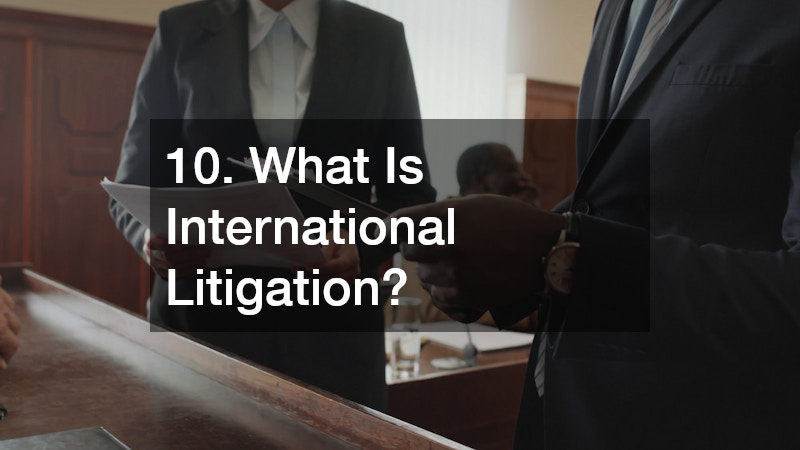
International litigation encompasses disputes that cross national borders. It is one of the most complex litigation types, involving different legal systems, treaties, and jurisdictions. These cases can include trade disputes, human rights claims, maritime issues, or cross-border contract violations.
Navigating international cases requires deep knowledge of both domestic and foreign laws, as well as procedural rules for enforcing judgments across countries. Jurisdictional questions—such as which court has authority—are often central to these disputes.
Parties engaged in global commerce, international employment, or cross-border property transactions frequently encounter these issues. A company seeking flood insurance coverage, for example, may find itself involved in international litigation if a dispute arises with a foreign insurer over policy terms or claim payouts.
Diplomatic considerations also come into play, as international cases can impact political and economic relations. Lawyers specializing in this field must coordinate with foreign counsel, interpret treaties, and navigate arbitration frameworks like the Hague Convention.
International litigation reflects the interconnected nature of today’s world and underscores the need for collaboration in resolving transnational disputes.
Understanding the various litigation types is essential for navigating the legal landscape with confidence. From civil and criminal cases to family, commercial, and international disputes, each form serves a distinct purpose and follows specific procedures.
This article has explored how these categories function, who they affect, and why they matter. Whether you’re dealing with a business conflict, environmental issue, or personal injury, recognizing the differences between these litigation types helps you identify the right legal support and strategies.
Ultimately, a clear understanding of these distinctions empowers individuals and organizations to approach legal challenges more strategically, ensuring fair outcomes and reinforcing trust in the justice system.
